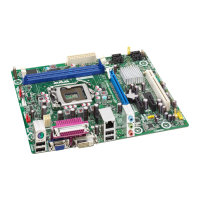Intel Desktop Board DH61CR Product Guide
22
NOTE
Software with Intel manageability capability is required to take advantage of the Intel
platform management capabilities.
Trusted Platform Module (TPM) Support
Intel Desktop Board DH61CR provides a header to connect to an external TPM. The
header is shown in Figure 1, R on page 12 and the header pinout is listed in Table 8 on
page 45. TPMs are designed to enhance platform security by providing a
protected
space for key operations and other security critical tasks. Using both hardware and
software, the TPM protects encryption and signature keys at their most vulnerable
stages—operations when the keys are being used unencrypted in plain-text form.
TPMs shield unencrypted keys and platform authentication information from software-
based attacks.
Fan Speed Control and Hardware Monitoring
The features of the hardware monitoring and fan speed control include:
• Thermal sensors in the processor and the Intel PCH, as well as near the processor
voltage regulators and system memory
• Monitoring of system voltages to detect levels above or below acceptable values
• Thermally monitored closed-loop fan control for all three fans that can adjust fan
speed as needed
• Support for chassis security feature that detects if the chassis cover has been
removed. The security feature uses a mechanical switch on the chassis that can be
connected to the chassis intrusion header on the Desktop Board.
Power Management
Power management is implemented at several levels, including software support
through the Advanced Configuration and Power Interface (ACPI) and the following
hardware support:
• Power connectors
• Fan headers
• LAN wake capabilities
• Instantly Available PC technology (Suspend to RAM)
• +5 V standby power indicator LED
• Wake from USB
• PCI Power Management Event signal (PME#) wakeup support
• PCI Express WAKE# signal support
• Wake from serial devices
• Wake from PS/2 devices

